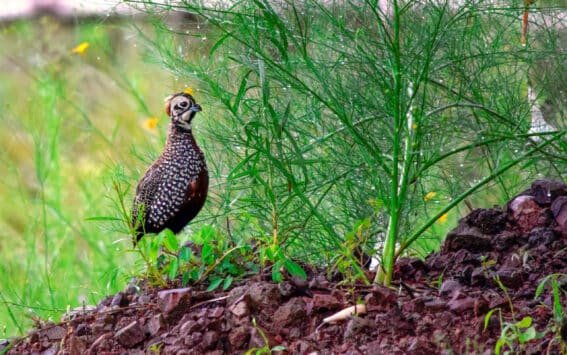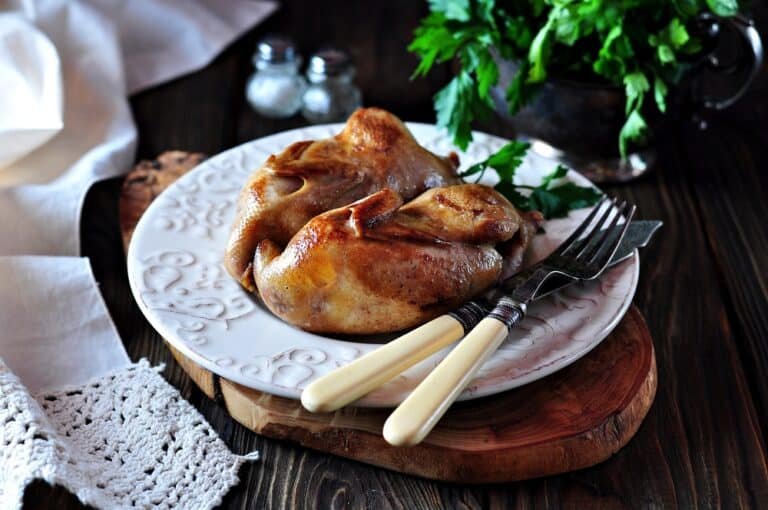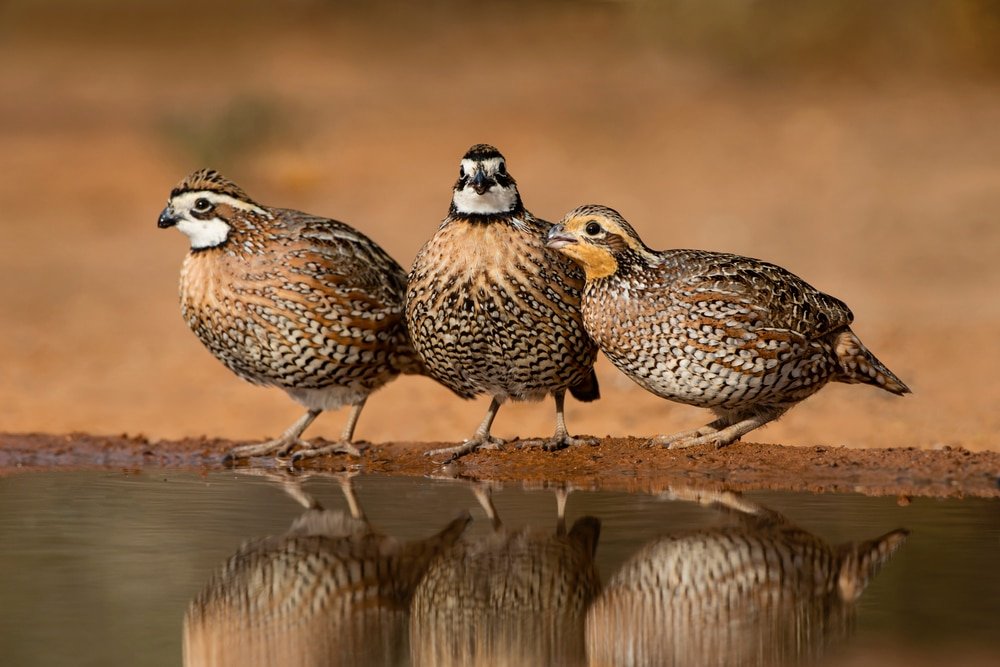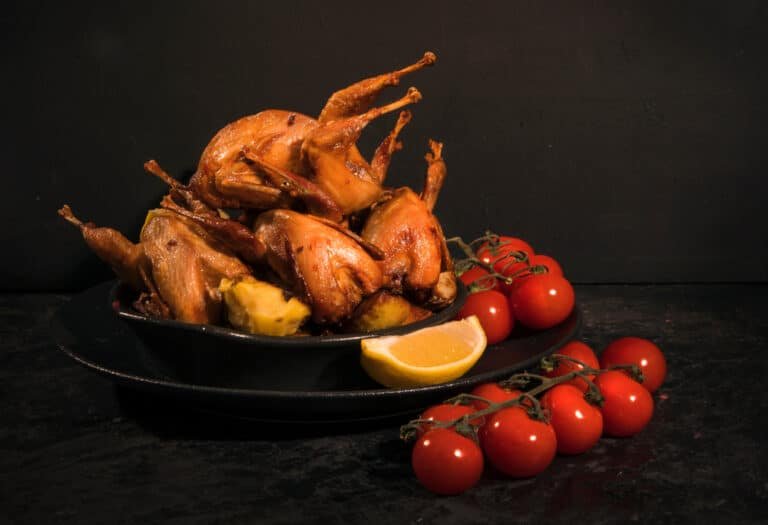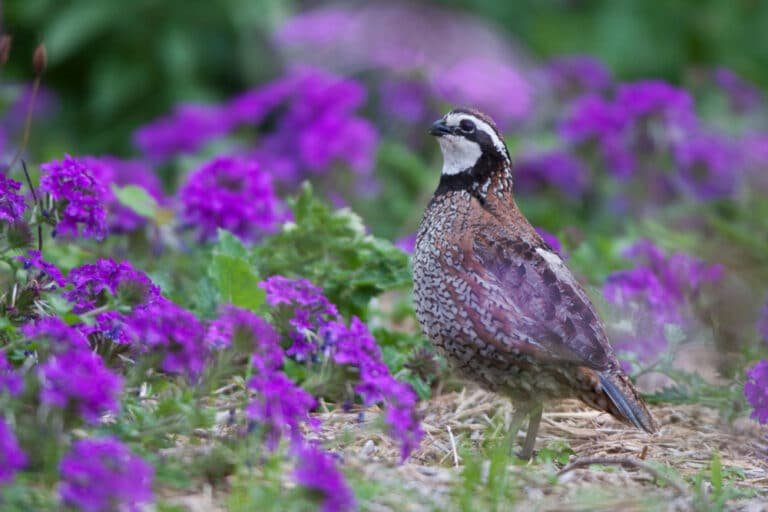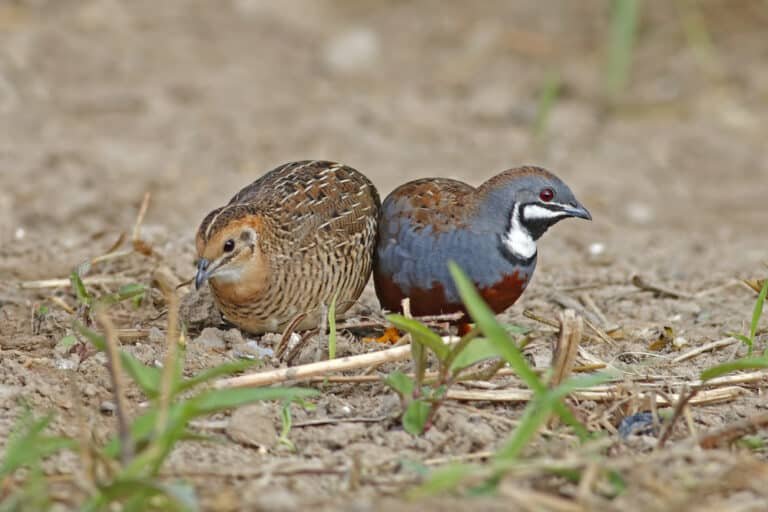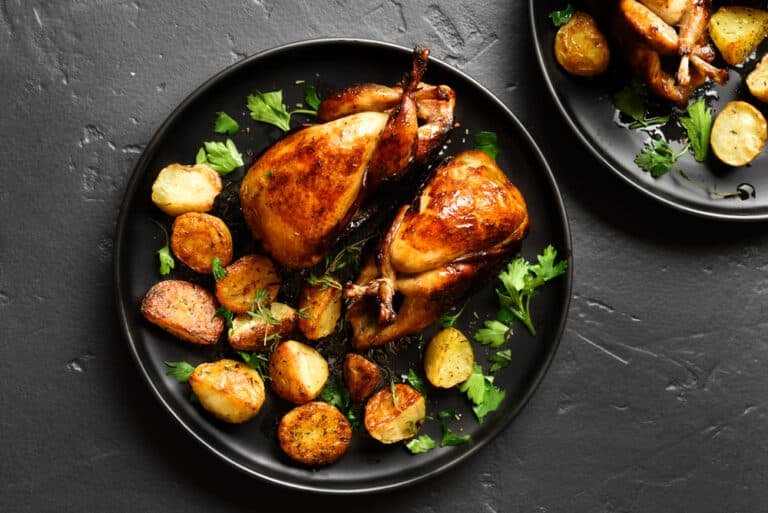Exploring the Unique Habitat of the Elusive Montezuma Quail
The Montezuma Quail, also known as Cyrtonyx Montezuma, is a fascinating bird species that inhabits the grasslands and shrubby areas of the southwestern United States and northern Mexico. Named after the Aztec emperor, Montezuma, this quail species is important in the natural world due to its unique characteristics and behaviors.
Brief Overview of Montezuma Quail
The Montezuma Quail is a small ground-dwelling bird that belongs to the New World quail family. It measures around 9-10 inches in length and weighs approximately 7-8 ounces. Its distinctive appearance can be easily recognized by its intricately patterned plumage and striking facial markings.
Importance and Uniqueness of this Species
The Montezuma Quail holds immense importance in ecological terms as it plays a vital role in seed dispersal and insect control within its habitat. This species primarily feeds on seeds, insects, and vegetation found on the ground, contributing to plant regeneration and maintaining a healthy ecosystem balance.
Its remarkable ability to blend into its surroundings through exceptional camouflage techniques sets the Montezuma Quail apart from other species. This allows it to remain hidden from predators while foraging or nesting.
Due to their secretive nature, this bird is rarely observed by humans, adding an air of mystery to their existence. In addition to their significance within ecosystems, these unique birds have captured the fascination of birdwatchers and wildlife enthusiasts alike.
Their elusive nature has become part of their allure, making sightings all the more special for those lucky enough to encounter them in their natural habitat. Stay tuned for our next section, where we delve into the physical characteristics that make these birds truly captivating!
Description of Montezuma Quail’s Appearance
The Montezuma Quail is a stunning bird with a unique and captivating appearance. It is a medium-sized quail, measuring 9-10 inches long and weighing approximately 8-10 ounces. The male and female quail exhibit sexual dimorphism, meaning they have distinct physical differences.
Males
The males are adorned with vibrant colors that make them quite the showstoppers. Their head and neck are adorned with a striking combination of glossy black and white feathers. The crown of their head displays a prominent coppery crest, while their face features a stunning blue mask that adds an air of mystery to their appearance.
Females
While the females lack the same vivid hues as the males, they possess an understated beauty that is equally captivating. They have mottled brown plumage that is excellent camouflage in their natural surroundings. Their feathers are intricately patterned with shades of brown, black, and white, which helps them blend seamlessly into the grassy landscape.
Distinctive Features – Plumage and Facial Markings
The plumage of Montezuma Quails is truly remarkable and sets them apart from other avian species. One striking feature is the intricate scalloping pattern on their feathers, especially noticeable on the breast area.
These delicate markings resemble fine brushstrokes or lacework and add an exquisite touch to their overall appearance. Another distinctive characteristic is the bold facial markings in both males and females.
However, it’s important to note that these markings vary slightly between genders. The males showcase a vibrant blue mask extending from the eyes to just below the beak, creating an eye-catching contrast against their black-and-white head coloring.
On the other hand, females exhibit more subdued facial patterns with a brownish hue around the eyes. In addition to their facial markings, Montezuma Quails possess other noteworthy features.
Their legs and feet are covered in sturdy scales, which aid them in traversing their preferred habitats of grasslands and shrubby areas. Furthermore, they have short tails with rounded tips, adding a cute touch to their overall appearance.
Overall, the Montezuma Quail stands out not only for its charming demeanor but also for its unique physical attributes. Its intricate plumage patterns and distinctive facial markings make it a true gem in the avian world.
Habitat and Distribution
Overview of Preferred Habitats: Grasslands and Shrubby Areas
With its unique beauty and charm, the Montezuma Quail can be found thriving in various habitats. The preferred habitats for these lovely birds include grasslands and shrubby areas. They possess a distinct fondness for areas where the land is covered in dense grasses, offering shelter and protection from predators.
These open grasslands provide ample opportunities for the quail to forage on seeds, insects, and other delectable treats. Additionally, they are equally at home amidst shrubby areas that offer a mix of low-lying vegetation and small bushes, providing ideal hiding spots when they need to retreat into seclusion.
Geographical Range: Southwestern United States and Northern Mexico
If you wish to catch sight of this alluring bird in its natural habitat, you’ll have the best luck exploring the vast lands of the southwestern United States and northern Mexico. From the oak woodlands of Arizona to the remote mountain ranges of New Mexico, Montezuma Quails enchant birdwatchers lucky enough to spot them.
Their geographical range stretches across these regions due to their adaptability to arid climates. These enchanting creatures embrace life in deserts, semi-deservedly as pine-oak forests at higher altitudes.
However, despite their wide distribution across this region, they are considered elusive due to their preference for concealing themselves among vegetation. Montezuma Quails naturally prefer grasslands and shrubby regarding their habitat selection.
They reside harmoniously in regions encompassing the southwestern United States and northern Mexico’s arid landscapes. With their remarkable adaptability and exceptional camouflage abilities among dense foliage or grasses, these birds effortlessly blend into their surroundings while thriving in their natural habitat.
Socializing in Style: Mating Rituals and Group Dynamics
Regarding social behavior, Montezuma Quail has quite intriguing dynamics. During the mating season, which typically spans from spring to early summer, these birds engage in elaborate courtship rituals that would make even the most seasoned romantics swoon. The male quail will display marvelous affection, puffing up his chest and spreading his tail feathers to catch a potential mate’s eye.
With graceful movements and a charming demeanor, he performs a delightful dance, bobbing his head and making soft cooing sounds of serenading the lucky lady quail. But it’s not just about impressing one bird – Montezuma Quail also form small flocks known as coveys for socializing purposes.
These coveys usually consist of a few males and several females with their offspring. By sticking together in a group, they can increase their chances of survival through collective vigilance against predators and sharing valuable information about food sources.
Masterful Camouflage: Surviving Through Adaptations
In their quest for survival, Montezuma Quail have developed remarkable adaptations that set them apart from other avian species. One of their standout features is their impressive camouflage techniques.
These birds possess intricate patterns on their feathers that blend seamlessly with the dappled sunlight filtering through their shrubby habitats. Their plumage showcases an exquisite combination of earthy tones like browns, grays, whites, and blacks.
This mottled coloration allows them to seamlessly merge with their surroundings among dense undergrowth or beneath grasses—and effectively disappear from prying eyes. Their ability to remain hidden helps protect them from threats ranging from raptors soaring above to land-based predators like bobcats or coyotes.
Moreover, Montezuma Quail’s adaptation extends beyond just coloration. Their behavior further aids in their survival.
When startled or threatened, these quail freeze in place, relying on their cryptic coloring to become virtually indistinguishable from the environment. This strategy of remaining motionless serves as a clever defense mechanism, allowing them to evade detection and avoid unnecessary conflict.
In their social interactions and ability to blend seamlessly with their surroundings, Montezuma Quail demonstrates fascinating adaptations that highlight the marvels of nature. These adaptations contribute to their survival and give us a mesmerizing display of beauty and ingenuity in the avian world.
Diet and Feeding Habits
Detailed explanation of Montezuma Quail’s diet, consisting mainly of seeds, insects, and vegetation
The Montezuma Quail is a versatile diner when it comes to its diet. These charming birds have an eclectic taste that includes various food items.
Seeds are a staple in their menu, making up a significant portion of their diet. They have a fondness for grass seeds like grama grass and sedge seeds.
In addition to seeds, these quail also relish insects like beetles, grasshoppers, ants, and caterpillars. They opportunistically snatch these critters as they scurry across the ground or fly air.
Furthermore, the Montezuma Quail isn’t shy about including vegetation in its culinary adventures. Their diverse menu includes tender leaves and shoots from plants such as cacti and forbs.
Foraging habits, including ground-feeding behaviors
To satisfy their gastronomic desires, Montezuma Quail adopts some fascinating foraging habits. Ground-feeding is one such behavior commonly observed among these birds. They are adept at scratching away leaf litter and loose soil with their stout toes to uncover hidden treasures like seeds or tasty insect morsels hiding just below the surface.
Their powerful belt allows them to deftly peck at the soil or leaf litter while searching for sustenance. Montezuma Quail can wander through open grasslands or shrubby areas with heads held low as they diligently scour the ground for food items.
Their keen eyesight helps them detect small movements caused by potential prey or edible plant matter nearby. With graceful movements and precise pecks, these quail can easily capture insects or pluck up seeds on the wing.
Additionally, these canyons swallow small stones or grit, which helps them break down seeds and aid digestion. The ground-feeding behavior of Montezuma Quails showcases their resourcefulness and adaptability in finding sustenance amidst their natural habitats.
Breeding and Reproduction
Mating season timing and courtship rituals
The Montezuma Quail is known for its elaborate courtship rituals, which take place during the breeding season. This season typically occurs from April to June, although it can vary slightly depending on the geographical location.
During this time, male quail engage in captivating displays to attract females. These displays involve a combination of vocalizations, fluttering wings, and exaggerated movements.
The males often gather in open spaces or clearings where they compete to win the females’ attention. It’s a sight to behold as these handsome birds put on a show to prove their worthiness.
Nesting habits, including nest construction and location preferences
Once courtship is successful, female Montezuma Quail begin their nesting preparations. They prefer to build their nests on the ground, often under dense vegetation or low shrubs that provide cover and camouflage for their eggs.
The nests are skillfully constructed using grasses, leaves, twigs, and feathers expertly woven into a sturdy structure. The female takes great care in selecting a suitable location that offers protection from predators and provides easy access for feeding.
Once the nest is complete, the female lays an average of 10-12 eggs over several days before incubation begins. The eggs are creamy-white with brown speckles that help them blend into their surroundings.
The incubation period lasts around 21-24 days, during which time the female remains dedicated to her nest, diligently turning and caring for her precious eggs. It’s fascinating how Montezuma Quail exhibits such remarkable breeding behaviors that ensure both successful reproduction and survival of their species in challenging environments where they reside.
Threats to the Species
Habitat loss due to human activities
One of the most significant threats facing Montezuma Quail is habitat loss caused by human activities. As urbanization expands, grasslands and shrubby areas that serve as their preferred habitats are converted into residential and commercial developments.
The clearing of land for agriculture also contributes to the destruction of their natural habitats. These alterations disrupt the delicate balance these quail rely upon for survival, forcing them to contend with fragmented spaces and reduced availability of essential resources such as food, water, and suitable breeding grounds.
Predation by natural predators
Predation is a constant concern for Montezuma Quail. They face threats from various natural predators, including coyotes, bobcats, foxes, and raptors like hawks and owls.
These agile birds have adapted remarkable camouflage techniques to blend seamlessly with their surroundings, but despite these efforts, they still fall victim to skilled hunters. Natural predators play a crucial role in maintaining ecological balance; however, when predator populations surge due to imbalances caused by human interference or other factors, it can intensify the pressure on Montezuma Quail populations.
Impact of climate change on their habitat
Climate change poses an additional challenge for Montezuma Quail and many other species worldwide. Rising temperatures alter precipitation patterns, resulting in more frequent droughts in some regions where these quail reside. This can lead to reduced availability of water sources critical for their survival.
Climate change also impacts vegetation dynamics; shifts in plant composition affect food availability and nesting sites for these birds. Additionally, extreme weather events like wildfires become more severe due to global warming trends – destroying large areas of suitable habitat that take time to recover.
Threats such as habitat loss due to human activities, predation by natural predators, and the impact of climate change are all significant factors affecting the survival of Montezuma Quail. It is imperative to address these challenges through conservation efforts and sustainable land management practices to ensure the long-term persistence of this remarkable species in its native habitats.
Conservation Efforts
Current conservation status
The Montezuma Quail, sadly, faces numerous threats to its survival. As a result, its conservation status has been classified as “Near Threatened” by the International Union for Conservation of Nature (IUCN).
This categorization reflects the dwindling population numbers and the rapid decline of suitable habitats for this unique bird species. However, it’s worth noting that there are ongoing efforts to halt the decline and restore their populations.
Measures taken to protect Montezuma Quail’s habitat
Conservation organizations and governmental bodies have implemented various measures to protect the Montezuma Quail’s habitat from further degradation. One crucial aspect is establishing protected areas and wildlife reserves where these birds can thrive undisturbed. These protected zones safeguard their habitats and provide sanctuary for other diverse flora and fauna that share these ecosystems.
Furthermore, habitat restoration programs are actively underway to reverse the damage caused by deforestation and human encroachment on their natural territories. Such initiatives focus on reestablishing critical features like native vegetation cover, adequate food sources, and suitable nesting sites.
Community involvement in conservation initiatives
Community involvement plays a pivotal role in successfully conserving the Montezuma Quail. Local communities living near their habitats are encouraged to participate actively in conservation efforts.
Awareness campaign to educate people about preserving these birds’ natural environment. Moreover, community-based monitoring programs have been established to gather data on Montezuma Quail sightings and population trends.
These collective efforts aid scientists understand their distribution patterns better and identifying areas that require immediate attention for protection. Volunteers also contribute significantly by engaging in citizen science projects that involve documenting sightings, conducting surveys, or participating in habitat restoration activities.
By fostering a sense of ownership among local communities, conservation initiatives are more likely to achieve long-term success and sustain the protection of this remarkable bird species. Various measures have been taken to protect the Montezuma Quail’s habitat and promote their conservation.
Establishing protected areas, implementing habitat restoration programs, and involving local communities are all crucial aspects of these efforts. By combining scientific research with community involvement, we can hope to reverse their declining population trends and secure a brighter future for these enchanting birds.
Fun Facts about Montezuma Quail
They are rarely seen due to their secretive nature.
Montezuma Quail, oh, how they love their privacy! These elusive birds are true masters of concealment. With their superb camouflage and stealthy behavior, spotting a Montezuma Quail in the wild is like finding a needle in a haystack.
Their feather patterns blend seamlessly with the dappled sunlight filtering through the vegetation, making them virtually invisible to predators, even birdwatchers—no wonder these mysterious fowls have earned a reputation as one of nature’s best hide-and-seek champions.
Males have a unique call that sounds like a bouncing ball
If you are to hear an odd sound akin to a ping-pong ball bouncing in the distance, chances are you’re near a male Montezuma Quail. These fine gentlemen have quite the distinctive call!
This quirky characteristic adds charm to these birds and is an auditory beacon among potential mates during the breeding season. So next time you encounter that peculiar bouncing ball sound while trekking through their habitat, take a moment to appreciate the unique symphony created by our feathered friends, the Montezuma Quail.
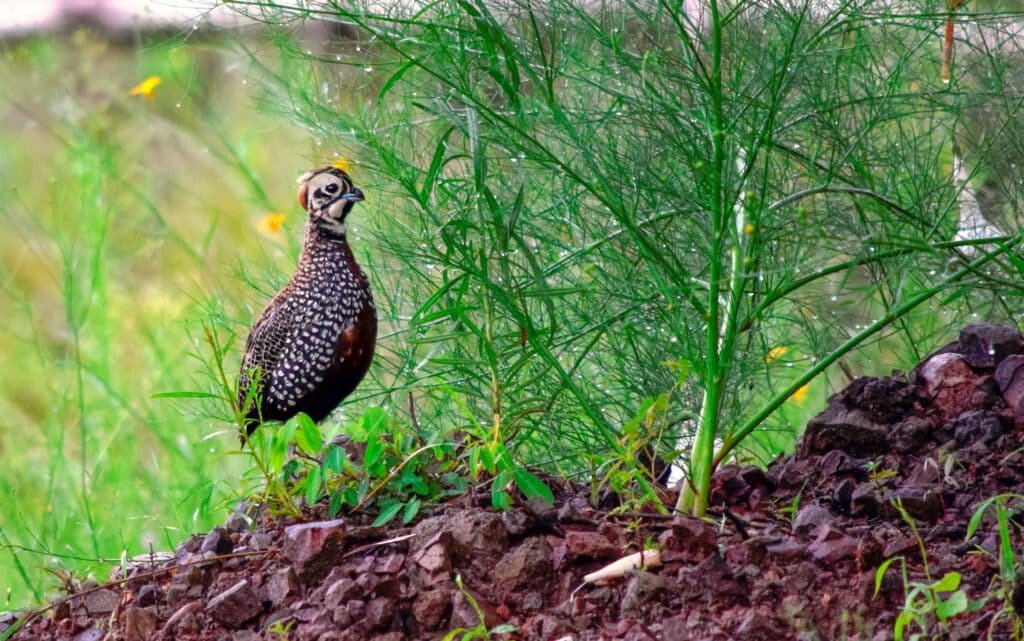
Conclusion
Recapping the Montezuma Quail’s Remarkable Attributes
Throughout this article, we have delved into the fascinating world of the Montezuma Quail, uncovering its unique physical characteristics, captivating behavior, and specific habitat requirements. With its striking plumage and intricate facial markings, this bird is truly a sight to behold. Its preference for grasslands and shrubby areas in the southwestern United States and northern Mexico make it an iconic species of these regions.
Understanding Their Behavior and Adaptations
We explored the social behavior of Montezuma Quails, learning about their intricate mating rituals and group dynamics. The quail’ ability to adapt to their surroundings is also truly remarkable. Their exceptional camouflage techniques help them blend seamlessly with their environment, providing them with a higher chance of survival against natural predators.
Habitat Requirements and Potential Threats
Montezuma Quails thrive in specific habitats that offer a mix of grasses, shrubs, and ample cover for protection. Unfortunately, human activities such as habitat loss pose a significant threat to their existence.
Additionally, predation by natural predators further challenges their survival. Climate change exacerbates these threats by altering their preferred habitats.
While there are challenges facing this enchanting bird species, there is hope on the horizon. Conservation efforts are underway to protect vital habitats and raise awareness about the importance of preserving biodiversity.
By working together to mitigate human impacts on their environments and implementing effective conservation measures, we can ensure a brighter future for Montezuma Quails. Let us appreciate the uniqueness of these creatures and strive towards coexistence that guarantees their continued presence in our world for generations to come.

